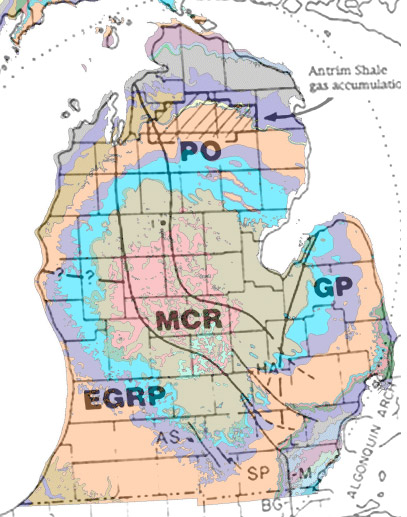Great Lakes Serpents
 Sea serpents surprise fisherman, sailors and swimmers
Sea serpents surprise fisherman, sailors and swimmers
Throughout history, when mankind has explored unknown territories, he has often populated the areas off of his map with strange beasts and beings. "There be dragons here" is the most popularly known notation and the undulating sea serpent is the most popular symbol found on early maps of the oceans. Until relatively recent times, people around the world had the commonly held belief that mythical beasts have populated fresh and salt waters. Large specimens of rare marine animals have explained many myths and legends brought down through the ages, however, some strange animal sightings have never been explained.
The undulating sea serpent is one type of mythical monster whose description hasn't changed across time, region, or culture. Although reported in oceans and seas (hence the name "sea serpent") this same serpent-type creature has been reportedly seen in large temperate lakes around the world. Examples include the most popularly known freshwater monsters from Loch Ness in Scotland, Lake Okanogan in Canada, and Lake Champlain in the United States. Given the tendency toward belief in water monsters, combined with the consistent and reoccurring sightings of an unknown animal, it is not surprising that the Great Lakes have a collection of curious creatures on record.
Although described as a large, fierce, and frightening creature, this sea serpent-type monster is usually given some cute names like Nessie, Chessie, Champ, and Ogopogo. Perhaps the possibility of some strange and dangerous predator stalking a favorite swimming hole compels people to downplay these monsters with funny, even friendly-sounding names. Personally, after reading numerous descriptions and some credible sightings in our own Great Lakes, it puts the fear of Jaws in me when I go swimming in the big lakes.
The most commonly described characteristics are a long snake-like animal that propels itself through the water with an up-and-down undulating motion that produces "humps" behind an uplifted neck and head. The most reported dimensions give it a length of about 30 feet and a diameter of 1.5 to 2 feet. The head appears like the head of a horse or camel with mouth whiskers, two small hornlike projections on top, and a "mane" that may be like that of a horse or less likely that of a lion (this is never specified in the reports). The skin is dark and either has small scales or smooth skin. The tail usually is said to end in a forked fin. Some reports have two small fins or legs below the neck and head area. Based on the time it spends underwater or hibernating under a frozen lake, it most likely breathes with gills or a combination of gills and lungs. Some reports claim that the monster issues a hissing sound upon surfacing, indicating the possibility of lungs. It is normally seen moving across placid lakes at a rapid speed or stretching out like a partly submerged log while resting. It has a row of sharp pointed teeth and is a carnivorous predatory animal.
The following is a list of lakes in the Great Lakes chain with their corresponding sea serpent sightings. None of these reports have been looked into for proper documentation, but if these sightings are to be believed, then the Great Lakes are swimming with these hideous monsters!
"Kingstie" the Lake Ontario Serpent
First reported as a "great snake" by early fur traders, a 30 to 40-foot-long, blackish snake-like creature has been sighted in Lake Ontario into the twentieth century. It was seen repeatedly throughout the 1800's up through the 1970s. In July of 1892 a married couple, while fishing on the lake, was supposedly attacked by a large serpent with "eyes like balls of fire". The husband, it is said, drove the animal off with his fishing pole. The nickname of "Kingstie" came from sightings in the Kingston area on the eastern portion of the lake.
Lake Erie's "South Lake Bessie"
Reports go back at as far as 1793 with sightings as recently as the summer of 1993. It is described as a snake or sea serpent ranging in size between 17 and 60 feet long. On August 24th, 1993, the 'Weekly World News' ran a classic sea serpent-style story about the attack of a 38ft sailboat by a "200-ton sea monster." The boat was "crushed like an eggshell" according to five witnesses. The photo published with the story was reported as taken by a low-flying aircraft in the vicinity.
Lake St. Clair Sea Serpent
In 1897 an "eel-like" sea serpent was reported to have dragged a horse out into the lake where it devoured it. That same year, a man at the Riverside Hotel reported seeing a creature moving at a "terrific rate of speed" in the Lake St. Clair flats.
"Mishebeshu" the Legendary Monster of Lake Huron
Ojibway legends relate the story of the water monster "Mishebeshu", or "great lynx", that had an underwater den near the Serpent River on the Canadian side of the lake. The monster legend is said to be responsible for the name "Serpent River".
Milwaukee River Serpent of Lake Michigan
In the late 1800s, or early 1900s, some commercial fishermen were setting nets in Lake Michigan near Jones Island when they saw the head of a large ferocious-looking beast above the surface of the water. During this period it was sighted again in Milwaukee Bay and the Milwaukee River at the Michigan Street Bridge.
"Pressie" the Serpent of Lake Superior
Sea serpents in Lake Superior have been reported since the late 19th century. One 1897 report says that a Detroit man fell overboard near Duluth MN and was attacked by a huge serpent that tried to constrict him. His three shipmates claimed to have witnessed the event. Reports have continued into the 1990s with one unofficial report claiming the monster pulled an adult whitetail buck underwater near Point Iroquois.
Comment about this article on the
Epress Forum Board
.
|
|
Michigan Earthquakes
 Michingan faultlines shown over bedrock map
Michingan faultlines shown over bedrock map
Although Michigan isn't known for having earthquakes, we do get a tremor every once and a while. I've experienced a couple while living in the Detroit area. The first one I "felt" was in January of 1986. This quake wasn't actually in Michigan but was centered in Painesville, Ohio, with a magnitude of 4.9, and was accompanied by several aftershocks too small to be felt in Michigan.
When I say I felt the quake, what I mean to say is that I "heard" the shockwave. I was attending classes at Macomb County Community College in Warren Michigan and that day I was allowed to explore the tunnels at the request of my design instructor. He sent me down there to look for "Old Nick" and scavenge discarded desk parts to design a computer stand. These tunnels between buildings were off limits to students since the 60s because of the fire hazard of student smokers. I never found "Old Nick" down there and the desks were uninspiring to me, but on the way out, before I left the tunnels, I heard what sounded like a block of steel, the size of a minivan, being dropped to the ground. A loud "boom" and reverberations through the tunnels caught my attention, but caused me no alarm at the time. After leaving the tunnels, I heard on the radio that we had a tremor, one that my instructor and other students hadn't noticed in the hallways above ground.
Another earthquake I experienced in the Detroit area was in the summer of 1986 or 1987. I didn't notice this quake, but my younger brother did. We were both at home that day and he said it felt like a large truck driving past the house (big trucks were a regular occurrence on our road). My bedroom window faced the street and so I learned to ignore the sound of traffic and didn't notice the tremor. This earthquake wasn't actually in Michigan but in Ohio or Illinois and it wasn't a very big one when compared to California's quakes, however, Michigan sits on the edge of a fault zone that has produced what might be the largest quakes to ever have occurred in the lower 48 states. This fault line is a hot spot known as the "New Madrid" fault and is centered on the Mississippi River where Missouri meets Illinois, Kentucky, and Tennessee
Throughout history, this New Madrid area in the lower Mississippi Valley has been the center of what might be the most massive earthquakes in North America. The largest recorded earthquakes on the New Madrid fault line were in 1811 & 1812 and are estimated to have magnitudes between 7.2 and 8.3. Nine tremors from the New Madrid earthquakes were reported as being felt in Detroit. Four catastrophic earthquakes occurred during three months. Hundreds of aftershocks followed over many years. Reports say that the earthquakes opened cracks in the earth's surface, caused the ground to roll in waves, and large areas of land to sink or rise. The first steamboat to travel on the Mississippi, the New Orleans, reported mooring to an island only to awake in the morning and find that the island had sunk below the waters of the Mississippi River. Damage was reported as far southeast as Charleston, South Carolina, and as far to the north as Washington, D.C. California might be waiting on the "big one" but chances are the "big one" could happen in America's Mid-west near St Louis, Missouri at the New Madrid fault line.
Michigan does have one fault running through the Keweenaw Peninsula in the UP and a few faults running through the Lower Peninsula. The Bowling Green Fault in Ohio comes north and turns into the Monroe Fault. The Monroe fault turns NW to become the Lucas fault that runs along the lower edge of the Mid-continental rift (in the middle of the lower peninsula). The Stony Point fault also runs from the southeast to the northwest near the Lucas fault. The Sanilac fault runs parallel to the Lake Huron coast near Port Huron Michigan. None of these fault lines are very active or dangerous, however, most of the quakes in Michigan happen below the mid-continental rift near the fault lines there. Although earthquakes are few in number and low in magnitude, Michigan has been the center of some "quakes around the lakes". The following is a list of earthquakes that have occurred here in Michigan.
Comment about this article on the
Epress Forum Board
.
|
Year
|
Date
|
Lat.
|
Long.
|
Mag.
|
City
|
|
1877
|
Aug 17
|
42.40
|
83.25
|
3.2
|
Greenfield
|
|
1938
|
Mar 13
|
42.08
|
83.17
|
3.8
|
Gibralter
|
|
1938
|
Mar 14
|
42.08
|
83.17
|
?
|
Gibralter
|
|
1947
|
Aug 10
|
41.928
|
85.004
|
4.7
|
Coldwater
|
|
1977
|
Oct 26
|
47.1
|
87.1
|
2.7
|
L Superior
|
|
1980
|
Apr 29
|
47.2
|
87.8
|
0.5
|
L Superior
|
|
1982
|
Nov 26
|
42.17
|
85.48
|
2.5
|
Scotts
|
|
1994
|
Sep 02
|
42.57
|
84.64
|
3.4
|
Central
|
|
2001
|
Oct 23
|
42.34
|
84.76
|
2.9
|
Prairie L
|
|



